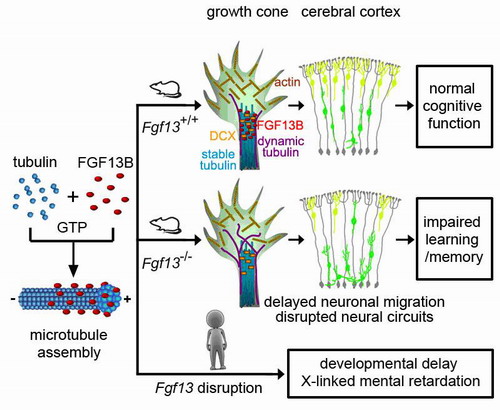Time:2012-06-24
On June 22, 2012, Cell published a research article entitled “Fibroblast growth factor 13 is a microtubule-stabilizing protein regulating neuronal polarization and migration”. This work was carried out by graduate students Qing-Feng Wu, Liu Yang and their colleagues, under the supervision of Prof. Xu Zhang.
Proper neuronal morphogenesis and migration are critical for establishing functional circuits in the cerebral cortex. Abnormal development of cerebral cortex could impair learning/memory and other cognitive functions of the brain. X-linked mental retardation (XLMR) is an inherited intellectual disability with abnormalities in neural development. Fibroblast growth factor 13 (FGF13) is a candidate gene for the XLMR. Most FGF family members are secretory proteins that function via their receptors on the cell surface. However, FGF13 is a non-secretory and cytoplasmic protein, and its function in development remains largely unknown.
This study carried out by Dr. Zhang’s research group shows that FGF13 is a microtubule-stabilizing protein required for axon/leading process development and neuronal migration in the cerebral cortex. They found that FGF13 was expressed in cerebral cortical neurons during development. The splicing isoform FGF13B was enriched in the axonal growth cones and directly interacted with microtubules. Furthermore, FGF13B polymerized tubulins and stabilized microtubules. Loss of FGF13B in cortical neurons impaired the transition from the multipolar to bipolar stage, and increased the branching of axons and leading processes. Genetic deletion of FGF13 in mice resulted in neuronal migration defects in both the neocortex and the hippocampus, and weakened spatial learning and memory. Thus, FGF13 is a key molecule required for the development of the cerebral cortical structures and functions. These findings reveal a mechanism for developmental disorders of the cerebral cortex and mental retardation.
This project was supported by grants from National Basic Research Program of China and National Natural Science Foundation of China.

This illustration depicts a model for the role of FGF13 on microtubule polymerization, microtubule stabilization in axonal growth cones, neuronal polarization and migration, and intellectual ability of animals.
 附件下载:
附件下载: